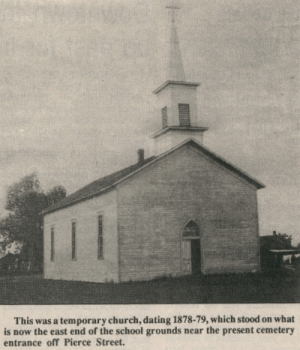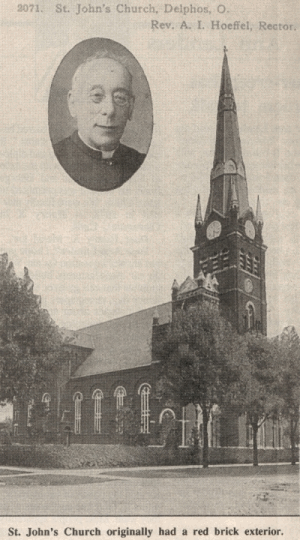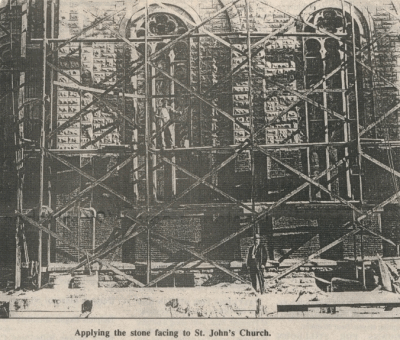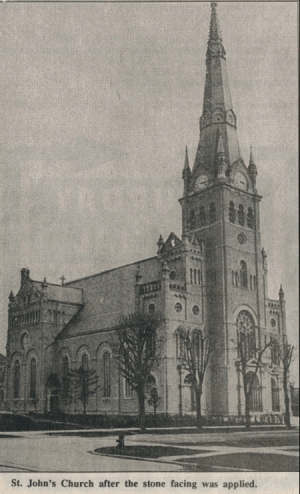
Window to the Past
The building and dedication of St. Johnís Church, 1878-1881
By BOB HOLDGREVE
Taken from the Delphos Herald
May 31, 1877 - St. John's Catholic congregation will not build a new church edifice this year, as has been stated. The matter has been under advisement for several months, but as yet no definite action has been taken.
Sept. 5, 1878 - The long contemplated erection of a new Catholic church in this place has at last assumed a tangible form. Ground is being broken for the new structure, which will be built in the form of a cross, with an extreme length of 192 feet. The width of the main body will be 78 feet, with 100 feet through the cross. The imposing front, with its wide portals, will have a width of 88 feet. The comb of the roof will rise 80 feet above the ground, leaving the center aisle 60 feet in the clear. A spire of 225 feet in height will tower above the whole massive structure. It is estimated that upwards of 1,200,000 bricks will be required in its construction. With these dimensions and corresponding ornaments, this building will be the grandest church in this part of the state. The foundation will be laid around the old building as high as the ground surface before winter. In the spring the old building will be removed and more vigorous work begun. At present the work is conducted by Francis Heitz and according to the plans of Samuel Wilford, architect, of Cleveland.
Aug. 12, 1880 - The cross was put in place on the spire of the new Catholic church, on Friday last. It looks rather diminutive, but really is large, measuring about 10 feet in height.
Aug. 19, 1880 - A Risky Climb - Mr. S. G. Roloson, the photographer, climbed to the top of the derrick pole about 10 feet above the cross on the new Catholic church spire, Sunday, being 235 feet above the ground, and wrote his name on the top. This is a high climb, and one which requires more nerve than is generally possessed by a man whose business does not require it. Mr. Roloson had a field glass with him, and says he was able to view quite an expanse of country, but the trees prevented a good view of the surrounding towns.
July 22, 1880 - Several young men of Delphos climbed the new Catholic church spire, today, taking with them a field glass, and reported being able to see Ottoville, Middle Point, Fort Jennings, and Elida.
July 15, 1880 - Narrow Escape - Mr. B. King, a carpenter employed in the erection of the spire of the new Catholic church, had a very narrow escape from a fall, on Friday last, which could not have ended otherwise than in a shocking death. Mr. King, together with other workmen, was engaged on top of the tower, at a height of considerable over 100 feet, in bracing the joints, when a gust of wind turned the one on which he was sitting, over on its side. His fellow workmen looked on in horror, expecting to see him dashed to pieces on the stones below; but with great presence of mind he grasped a joist which was braced, and succeeded in gaining a solid foothold.
Sept. 2, 1880 - Wednesday of last week the spire of the new Catholic church was struck by lightning, and damaged to the extent of about $200.
Sept. 16, 1880 - The big bell has been put in position in the new Catholic church spire.
Oct. 14, 1880 - At last the spire of the Catholic church has been slated. The work was done by Mr. B.E. Smith, of Wooster, Ohio, and speaks well for his ability.
Dec. 2, 1880 - Presentation - Friday afternoon last, a number of the prominent members of the Catholic church of this city, assembled at the parsonage, and after the attendance of Mr. C.D. Nolan had been secured, Father Hoeffel stepped forward and spoke as follows:
Mr. Nolan: I have the honor of presenting to you a fine clock, a beautiful timepiece, which I have not the least doubt, would adorn the grandest parlor. I present it to you as a momento from St. John's Evangelical Church of Delphos, to remind you at all times and hours of the exactitude of skill and promptness with which you have executed the plans of plastering and stucco of our new church. Not one that I have heard in the course of six months has fault, but all had words of praise for your work. In fact, here I can say, when looking at the inside work, the work praises the Master. May you count many, yes very many hours on this clock. In a word, may God grant to you a long life that you may have many chances to finish such noble structures, for the greatest honor and glory of the Most High.
Mr. Nolan responded in a feeling manner, thanking Father Hoeffel and those present for this evidence of their good will. After a pleasant hour of conversation the party dispersed. The clock is a beautiful one and truly would adorn any mantelpiece. We are glad to see that those interested, appreciate Mr. Nolan as a gentleman and a workman. God didn't make so many men after that pattern that they will pass through life unappreciated and unknown. His work on this church speaks for his skill as a workman, and the many warm friends who gathered around him during his stay here, attest to his social and moral worth.
Dec. 23, 1880 - The cost of the new church is estimated at $50,000. The standing debt will be only $6,000 or $8,000.
It is a note-worthy fact that up to date, there has been no accident of any kind in the erection of the new church.
Jan. 16, 1881 - Sunday was as fine a day as could be expected at this season, and long before the hour appointed for the services to begin people from the surrounding country began to arrive in sleighs and on foot, until at 9:45 when the procession moved a large concourse of people were on the streets to witness the march. About 10 o'clock the excursion trains began to arrive bringing large crowds of people. The one from the north on the T.,D. & B. had three coaches packed with people, the one from the west three coaches, and the one from the south two coaches, while those from Lima and Van Wert respectively brought quite a number.
At 9:45 the procession formed in the following order at the parochial residence, the different societies carrying rich banners and emblems of their orders, and most of them wearing appropriate badges and sashes: Germania Band, Children of the Schools, St. Rose Young Ladies' Sodality, St. Aloysius Young Men's Sodality, Church Choir, Rt. Rev. Bishop Gilmour accompanied by Fathers Westerholt, St. Peter's Church, Cleveland; Scholosser, St. Jose, Cleveland; Dickman, Glandorf, O.; Kallop, Norwalk, O.; Miller, Ottoville, O.; Peters, Fort Jennings, O.; Highland, Landeck, O.; Henry, Lima, O.; Lanf, Oxford, Ind.; Barry, Van Wert, O., and Hoeffel of Delphos; the Ladies' Altar Society, St. Joseph Society, and last, Members of the Congregation, and marched to the new church.
When the head of the procession reached the church the column divided in open order and assumed a kneeling posture, when the Bishop and clergy marched between the ranks pronouncing benedictions upon the different societies as they passed. After the clergy had reached the head of the procession the ranks again closed, and the service of blessing the outside of the church was held. This service consisted of a benediction by the Bishop and a service of song, during which the clergy marched around the building. When the outside had been blessed, the clergy, headed by the Bishop, entered and consecrated the inside of the church to the service of God, after which the doors were thrown open and the people admitted. But a few minutes were required to pack the large building with nearly three thousand people while many were compelled to go away for want of room. The exclamations of surprise and admiration for the beautiful edifice were almost as varied as they were numerous and hearty. When the church had been filled, the choir, accompanied by the Philharmonica orchestra, began singing Mozart's 12th High Mass, which was grand, sublime. This is one of the finest church choirs we have ever heard, possessing excellent musical talent and being finely trained. The tone of the organ is much improved by the parts that have been added to it, and together with the orchestra and the voices of the choir fills the immense building with a musical cadence that would thrill the most lethargic heart. When the mass had been sung Bishop Gilmour entered the pulpit and delivered an able sermon, congratulating the Catholics of Delphos on having such a fine church, and expounding the doctrines of the Catholic faith.
At the conclusion of the bishop's remarks Father Westerholt, of Cleveland, who was formerly pastor of the church, delivered a German discourse, after which a German "Te Deum" was sung and the congregation was dismissed. At 3:30 o'clock in the afternoon vespers were held at which the blessed sacrament was administered.
Feb. 24, 1881 - A fire caused by spontaneous combustion burned a large hole in the floor of the new Catholic church one morning last week. The fire department was not called out.




Compiled by Robert Holdgreve
President of Delphos Historical Society
January 16, 1998 Delphos Herald Newspaper